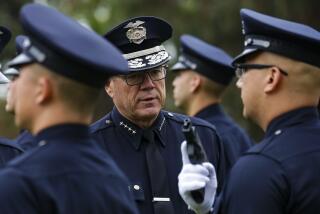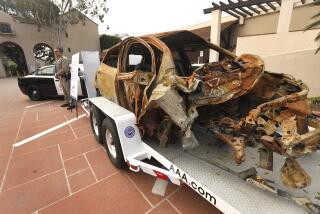S.D. Experts to Analyze Driver Fatigue
- Share via
SAN DIEGO — Researchers here and in Goleta will launch the first major study in more than a decade to analyze when drivers experience fatigue and how long they can remain alert behind the wheel, officials said Tuesday.
Scripps Clinic and Essex Corp. researchers will monitor long-haul truckers on the road, measuring their wariness and wakefulness, during the two-year, $1.3-million study funded by the Federal Highway Administration and the trucking industry.
The results will be used by the Federal Highway Administration to evaluate current national law, which allows truckers to drive 10 hours a day between states provided they go off duty the next eight hours. Federal officials have had little data to figure out whether the law--in place and unchanged since 1939--still makes sense.
“This study is going to be a significant contribution to the field because we intend to establish measurable relationships between drivers’ activities and physical, psychological and cognitive indicators of fatigue and the loss of alertness,” said Deborah Freund, an FHA transportation specialist and project manager for the research. “There are going to be a lot of people looking at this.”
While assisting government officials to review existing regulations, researchers say they also hope to devise methods for drivers to avoid sleepiness at the wheel and the accidents it causes. As they try to compile such a list, researchers will examine, for instance, how drivers are affected by caffeine in coffee and soda, as well as the effectiveness of naps.
“Hopefully, we’ll . . . provide advice to drivers and trucking companies in terms of useful things they can do to minimize the effects of fatigue,” said Dennis Wylie, principal investigator of the study and director of the human factors research department at Essex Corp., a small private research firm in Goleta.
Today, some truckers are pressing to increase allowable interstate driving hours to 13 each day, which is the legal limit in Canada. Others, however, advocate shortening the hours, saying a shorter workday could lead to fewer accidents.
Within California, truck drivers are allowed to drive no more than 12 consecutive hours. As long as the drivers remain within state boundaries, these more lax regulations do not conflict with the national ones.
Sleep deprivation and fatigue account for more than one-half of the nearly 15 million car and truck accidents nationwide each year, according to some studies, said Merrill Mitler, research director of Scripps’ Sleep Disorder Center, who has studied the relationship between sleep and human error.
“Truck accidents are a major loss of life,” Mitler said. “Anything that the trucking industry and government can do to identify factors that contribute to accidents would be most welcome in trying to limit those accidents.”
Across California in 1990, 556 people were killed and 16,514 were injured in truck-involved accidents, said California Highway Patrol spokeswoman Alice Huffaker. In San Diego County, 26 were killed and 824 injured in such accidents during the same year.
With this toll in mind, state and national highway safety officials, along with industry representatives, will carefully watch the study results.
“It’s an economic issue as well as a safety issue,” said Clyde Woodle, executive director of the Trucking Research Institute, the research arm of the American Trucking Assn., which is helping to finance the study.
The joint industry-government endeavor--an unusual partnership--may well be the wave of future studies, Freund said.
Unlike previous studies, the truckers actually will be driving in the everyday environment--not a simulated one--and they will not be hired for the sake of the study.
Under the study, about 100 volunteer drivers will allow Scripps researchers to monitor their bodies, measuring their heart beat, heart rate variation, brain waves, eyeball movement and their body temperature while they sleep and while they drive.
Body temperature is an important indicator of energy levels because once every 24 hours, the body’s temperature drops to a low point. At that time, the person is particularly susceptible to fatigue, Wylie said.
To enable the researchers to take these types of measurements, the drivers will wear electrodes attached to their chest and a special elastic cap that resembles a swimming cap. This cap has sponge contacts inside that touch the scalp--picking up electrical signals to the brain.
While the drivers sleep, researchers will monitor their chin muscle movements and the amount of oxygen in their blood. A device that clips on to the driver’s earlobe or fingertip when he sleeps indicates whether he is getting sufficient oxygen. With this device, researchers will be able to detect sleep apnea among the drivers--a disorder in which a person’s irregular breathing results in inferior-quality sleep.
For the study, researchers will focus on truckers who are traveling back and forth on one route--not taking a circuitous route that could last days. This way, technicians can attach monitors to the drivers when they are ready to sleep.
“We don’t say this represents all kinds of trucking, but we feel we are capturing the important essence of many kinds of trucking operations,” Wylie said.
The drivers will be studied as they travel real routes lasting five to 17 days. At the beginning of each trip, during the middle and at the end, drivers will be asked to perform a 20-minute test on a device similar to a computer game key pad. They also will be quizzed about their sense of well-being, road conditions, quality of sleep obtained and substances (caffeine, medication, cigarettes) used during their trip.
Within the truck cab, two small video cameras will record the view of the road and the driver’s eye movements. Another camera, mounted on the truck’s exterior, will monitor lane position, because experts believe lane changes are related to a driver’s fatigue.
Another device will be hooked up to the steering column to measure changes in steering angle and steering conditions.
“Tired drivers tend to make larger, less frequent steering-wheel corrections than alert drivers, who make numerous small corrections,” Wylie said.
The Federal Highway Administration last conducted two studies of drivers during 1972 and 1978.






